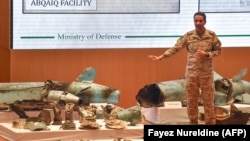U.S. Secretary of State Mike Pompeo has responded to Iran's threats of "all-out war" by saying the United States "would like a peaceful resolution" to the crisis sparked by a weekend attack on Saudi Arabia's oil infrastructure.
After meeting with allies in Saudi Arabia and the United Arab Emirates (U.A.E.), Pompeo said on September 19 that there was an "enormous consensus in the region" that Iran carried out the attack, despite its denials.
Two senior Iranian officials have threatened a "swift and all-out response" in case the U.S. or others launch military action against Iran.
Iran's Security Chief Ali Shamkhani has threatened a "swift and all-out response" in case the U.S. or others launch military action against Iran, semi-official Mehr news agency reported Wednesday. Foreign Minister Javad Zarif has also said in an interview with CNN that any military action against Iran will lead to an all-out war with heavy casualty.
Nearly a week after dozens of missiles and drones hit two major oil facilities in Saudi Arabia and halved the kingdom's oil production, Iran's reaction is still one of defiance and threats while many fingers point at Tehran as the culprit.
Speculations about the origin of strikes on eastern Saudi Arabia have been changing and becoming gradually more precise as unnamed U.S. officials leak more intelligence.
First, a Trump Administration official told ABC News on Wednesday it was Iran that launched the attack using "a dozen cruise missiles and over 20 drones from its territory."
At the time, military analysts were still not sure whether the strike was launched from a place in southern Iraq or southwestern Iran near the mouth of the Persian Gulf.
However, on Thursday, a CBS News report shed more light on the location where the strike was planned and carried out, quoting another U.S. official as saying that the United States has access to unpublished satellite images that show IRGC officers preparing the attack at Ahvaz airbase in southwestern Iran.
CBS News added that Iran's Supreme Leader Ayatollah Khamenei knew about the attack and approved it on the condition that Iran's involvement could be denied.
Although the U.S. may not show the satellite images before making sure that they do not compromise key intelligence by making them available to other players including Russia and China, talking about Khamenei's approval may indicate wire, or rather wireless, tapping or tip-off by agents on the ground, which is hard to believe, although Khamenei has spoken about "infiltrators" at various occasions.
Meanwhile, Saudi Arabia broke its cautious silence about who was responsible on Wednesday, blaming Iran, as Secretary of State Mike Pompeo who was visiting Riyadh also blamed Iran and called the strike "an act of war."
The Saudis on Wednesday showcased wreckage of what they called were parts of Iranian missiles and drones and pointed fingers at Iran.
In the meantime, Iran continued denying its involvement in the attack. Foreign Minister Zarif and other officials including President Hassan Rouhani denied reports about Tehran's involvement, insisting that Yemen's Houthi rebels were behind the attack.
In an attempt to clear Iran from the charges of involvement, some Iranian journalists have tweeted that Houthi rebels are going to have a news conference later in which they will say they have launched the attack from inside Saudi soil after a 100 kilometer penetration.
Hossein Salami the commander of Iran's revolutionary guards (IRGC) said on Thursday that everyone was blindly blaming Iran for the attack because they knew "Iran is powerful".
A day earlier, Iran's Security Chief Ali Shamkhani denied Iran's involvement in the attacks on Saudi Arabia and warned against military action against Tehran. He said, "Any military action against Iran will be harshly responded to in a way that would surprise the attacker."
Earlier, in a letter handed over to the U.S. interest section in the Swiss embassy inTehran, the Iranian Foreign Ministry warned against possible military action by America. "If an action takes place against Iran, Tehran will react immediately, and Iran's reaction will not be limited to where the threat has originated from," Official news agency IRNA cited from the letter.
The statement is consistent with Iran's asymmetrical warfare strategy which is based on responding to threats at a time and place the adversaries do not expect.
Shamkhani warned in a strongly worded statement that Iran's response will be "swift and all-out."
Meanwhile, he claimed that the Yemen’s Houthis make their own weapons and attributing such weapons to other countries is part of a blame game.
Since the beginning of the war in Yemen in 2015, several reports have indicated that Iranian-made weapons including drones made in 2016 and 2017 have been detected or seized in Yemen where Iran backs the Houthis fighting Saudi and other forces.
Iran's influence in Yemen dates back to late 1960s and early 1970s when at times Tehran deployed up to 3,000 troops to Yemen to ward off Soviet-backed Marxist-Leninist influence. However, Tehran's current involvement in the war is motivated by regional rivalry with Riyadh and religious sentiments to back the Shiite Houthis although the sect is essentially different from the brand of Shiism in Iran.





